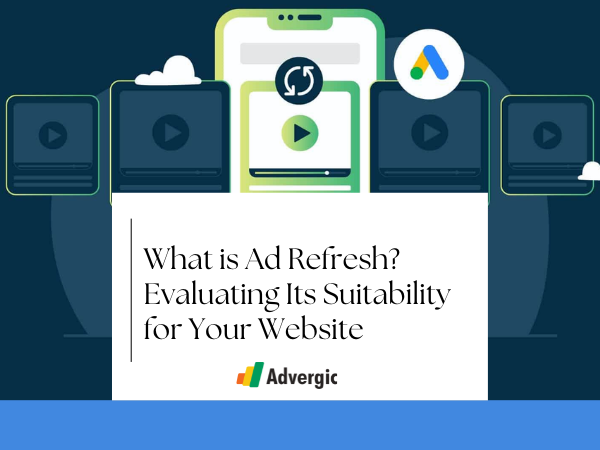The Internet is known for catering to short attention spans with its abundance of short videos, articles, and…
The Internet is known for catering to short attention spans with its abundance of short videos, articles, and answers. As a result, it is reasonable for these types of pages to only display one set of advertisements. However, for longer reads such as in-depth articles or extended listicles, or for pages that are likely to be left open for an extended period of time (such as a recipe or set of instructions), the initial ads may be replaced with a new set after some time has passed.
The practice of replacing ads after a certain period of time is commonly referred to as “ad refresh.” Depending on your website, this could be an effective strategy for maximizing your monetization.
Understanding Ad Refresh
Ad Refresh is a strategy that enables publishers to boost the quantity of ad impressions per pageview by reloading ads for engaged users on the site after they have been on the screen for at least 30 seconds. By refreshing the ad inventory, publishers can update the ad content without the need to refresh the entire webpage.
What advantages does Ad Refresh offer?
By refreshing your ad units, you can easily expand your ad inventory and potentially increase your revenue. This strategy allows for more impressions, which often translates to more profit. Instead of adding additional units to a page, refreshing a unit offers a promising opportunity. In addition, if any ads were not successful in generating clicks, new ads may be more suitable for the user, leading to increased relevance. Essentially, the primary advantage of Ad Refresh is the ability to boost ad revenue by gaining more impressions or clicks without requiring more traffic or slowing down page load time.
Are there any potential disadvantages of Ad Refresh?
When it comes to ad monetization, the truth about Ad Refresh is not as straightforward as just enabling it and expecting to see a boost in revenue. While refreshing ad units can potentially increase earnings, it can also have the opposite outcome, and if done incorrectly, it may even result in being prohibited.
There are differences in policy regarding ad refresh between AdSense and AdX. In general, AdSense discourages ad refresh, while AdX permits it as long as it is declared. Let’s examine both scenarios more closely.
Updating AdSense advertisements
The general guideline is to refrain from refreshing ads, unless it is initiated by the user. In other words, it is acceptable to load a new ad when the user interacts with the page, but not solely based on the amount of time that has elapsed.
A legitimate way to refresh would be to initiate a new ad request when the user navigates through a slideshow. However, if the slideshow is automatic and does not require any user interaction, refreshing would not be permitted. This is a key factor in why publishers choose Ad Exchange instead of AdSense – continue reading to learn more.
The language used in certain articles on the Google Ad Manager Help pages can cause confusion among publishers regarding this matter. However, the AdSense policy is unambiguous.
According to Google AdSense’s guidelines, publishers are prohibited from automatically refreshing a page or any of its elements unless explicitly requested by the user.
Updating Google Ad Manager Ad Exchange advertisements
The AdX platform by Google Ad Manager offers increased versatility with its rules system. By using AdX, you have the ability to automatically reload or refresh ad units, but only if you clearly state that this is your practice. This statement gives buyers the option to determine if they want their ads to appear in refreshing ad units. Not indicating which parts of your inventory will have auto-refresh is considered a breach of Google’s policies.
Steps for declaring ad inventory that automatically updates on Ad Exchange
To declare your refreshing inventory, go to INVENTORY > AD EXCHANGE RULES > PUBLISHER DECLARATIONS and create a new display publisher declaration.
The declaration requests that you specify the factor that initiates a refresh:
- User behavior: Ads will only change if a user manually navigates. There is no set time for ads to refresh in this scenario. This approach may be suitable for single-page applications that allow users to navigate without loading a new URL.
- Event-driven content changes: Ads are refreshed when specific events, predetermined by the publisher, occur. These triggers can only be used to refresh ads after a minimum of 30 seconds. For instance, when a publisher updates a page with new content, this can trigger the ad to refresh.
- Time intervals: The ad will refresh based on the time that has passed. There must be a minimum of 30 seconds between each refresh. For example, ads may refresh after 120 seconds have elapsed.
One of the benefits provided by Ad Exchange is the increased flexibility in implementing ads. To discover more about Ad Exchange, read our blog.
Factors to consider for generating income
There is no guarantee that refreshing your ad unit will result in a revenue increase, especially in the short term. Factors that should be taken into consideration include:
- Certain advertisers may choose not to bid: When ad units are frequently refreshed, it may discourage some advertisers from bidding on them. This could lead to a decrease in the cost per thousand impressions (CPM).
- Viewability and CTR may suffer: This is especially true for auto-refreshed ads that are based on time intervals rather than user interaction. In such cases, the viewability may be negatively affected since the ads are not always visible to the user. This can decrease the value of the inventory.
- Bids may decrease: Some advertisers may find refreshing ad units to be less effective, leading to a decrease in bids and overall performance. This can ultimately result in lower CPMs.
- Emphasis on increasing quantity: The aim of Ad Refresh is to compensate for the potential decrease in bids by increasing the volume of ads. When implementing Ad Refresh, it is important to consider the value of page views and the average user worth. This involves analyzing both Page RPM and Session RPM, rather than just Impression RPM.
- CPC ads may have lower performance: Since each ad unit can only be clicked once, publishers with a high number of cost-per-click (CPC) bidders may not see significant benefits from refreshing ads. In fact, their yield may even decrease if the highest bidder’s ads are not seen by users.
- Duration of user engagement: If a large number of users are spending less than 30 seconds on a page, auto-refreshing may not have a significant impact. This means that some of the negative effects mentioned above, such as discouraging bidders, may still apply, but the benefits will not be realized as users are not staying on the page long enough to experience a refresh.
Factors to Consider for User Experience
The initial page load is not affected by Ad Refresh, but it does require extra data when ads are reloaded. Reloading ads involves loading more creatives, but this does not interfere with the user’s access to the content.
Websites that are frequently accessed through mobile devices (especially when not connected to Wi-Fi), those that already have large pages, and those with users who have slow internet connections will experience the most impact on their loading time. It is important to take into account the types of advertisements you allow, as the loading time can vary significantly between a refreshing text unit and a refreshing rich media unit.
Steps to update ad units
Taking all of this into account, utilizing auto-refreshing units is a feasible strategy for many individuals and we highly recommend that publishers give it a try. The most convenient method of implementing this is by utilizing the feature already built into Google Ad Manager (see this link for instructions).
To effectively implement asynchronous GPT tags, it is necessary to specify a custom refresh period in milliseconds. It is important to adhere to the minimum values specified above.
Concluding Thoughts
You now have to evaluate the advantages and disadvantages that we have presented in order to determine if implementing Ad Refresh on your page is a viable option. If your content is suitable for longer session durations, then you have a strong reason to give it a chance, as long as you do it correctly.
It is important to closely monitor your metrics before and after making any changes to this kind of implementation. This will allow you to determine if the changes are effective. If they are not producing the desired results, you always have the option to revert back. In addition, implementing other tactics to reduce bounce rates and improve session durations can further enhance the effectiveness of this strategy on your website.
If you want to learn more about ways to earn money from your website, you can check out our blog. Additionally, if you are seeking a partner to improve your monetization strategies or are interested in header bidding monetization, Ad Ops Management, or optimizing your ad bidding system, get in touch with us now.
Have questions about Header bidding wrapper and price granularity?
Schedule a free consultation with our Header Bidding Expert today 📞

